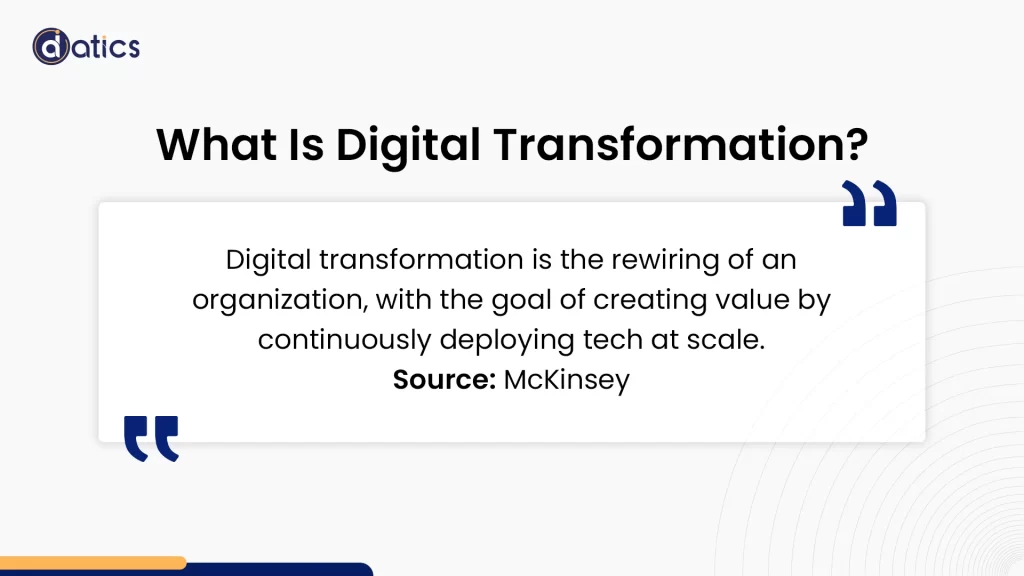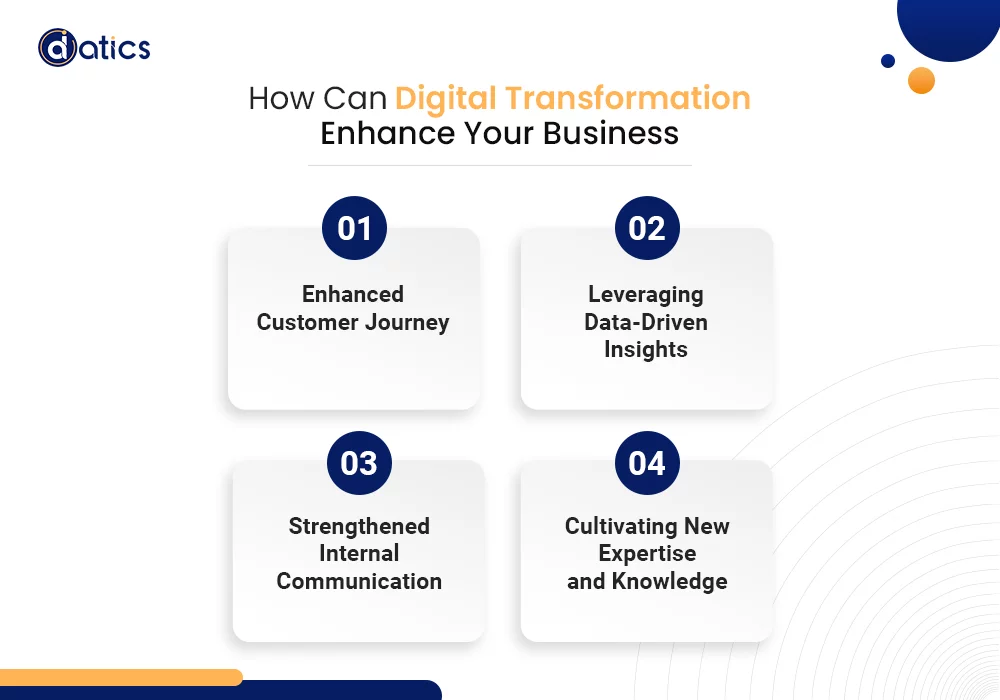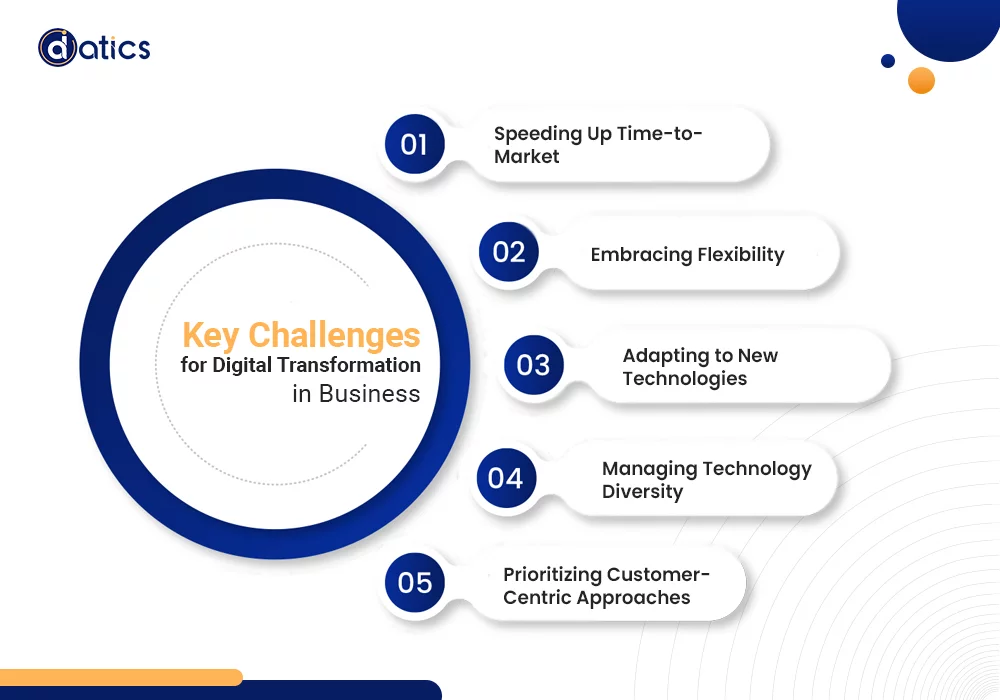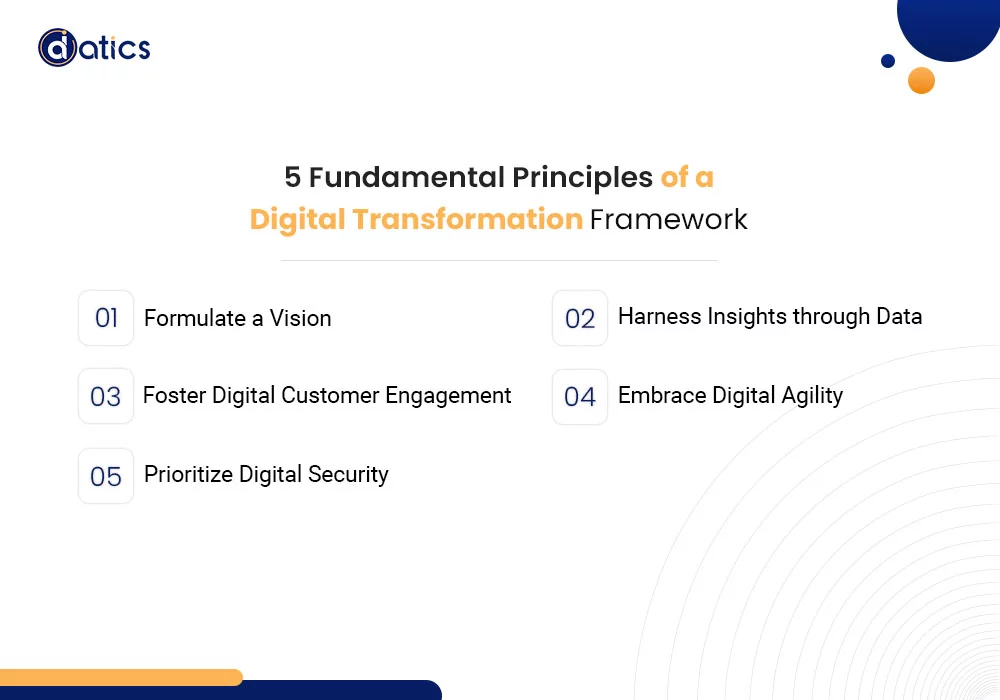
© 2024 | All Right Revered.
Understanding the buzzword “digital transformation” that has gained momentum in the ever-evolving realm of modern business.

Marketing Strategist
A data-driven Marketing Strategist passionate about empowering businesses to thrive through informed decision-making.

The term “digital transformation” has gained substantial traction since the internet revolution of the 1990s, leading to a significant reshaping of the contemporary business landscape. With a staggering global investment exceeding two trillion dollars in digital transformation efforts, its role in modern enterprises cannot be understated.
With the integration of pioneering technologies such as the Internet of Things (IoT), machine learning, and cloud computing, the operational dynamics of modern businesses have witnessed a significant transformation. Computers and digital technologies have become indispensable in shaping the current business ecosystem.
In today’s rapidly evolving business environment, characterized by the continuous need for adaptation and innovation, digital transformation assumes a pivotal role. It represents the holistic restructuring that businesses undertake to ensure their competitiveness and relevance in the digital age.
If you find yourself intrigued but unsure about what this term really entails, fear not! We’re here to guide you through the intricate details and unveil the essence of this buzzworthy concept. Let’s embark on this transformative journey together and decode the world of digital transformation.
In essence, digital transformation refers to the process of integrating and leveraging rapidly evolving digital technology to resolve challenges and enhance business operations.
This can manifest as the adoption of cloud computing to streamline hardware requirements or the implementation of automation to redefine workplace dynamics. Technology can penetrate every facet of a business.
Yet, this transition encompasses more than just technology. It necessitates a cultural shift within the organization, demanding openness to experimentation and adaptation among employees to seamlessly incorporate new technological advancements.
Digital transformation fundamentally redefines how businesses deliver value to their customers. While it entails copious amounts of data and novel technology, maintaining a customer-centric approach remains the key driving force propelling businesses forward.
When executed effectively, successful digital transformation empowers companies to initiate, evaluate, and modify digital initiatives, enabling them to adapt to evolving market conditions and better cater to the ever-changing needs of their customers.
According to McKinsey,
“Digital transformation is the rewiring of an organization, with the goal of creating value by continuously deploying tech at scale.”

According to the 2022 CEO Outlook report from KPMG, the majority of CEOs (72%) maintain a focus on digital investments. Digital transformation has evolved into an essential and universally significant aspect for businesses, regardless of their size or field. The importance and inevitability of digital technology are undeniable.
Here at Datics AI, we understand that the concept of digital transformation can seem abstract, particularly for those without a technical background. Grasping the full scope and form of digital transformation can pose a challenge.
For us at Datics AI, the value of digital transformation lies in our dedication to guiding our clients towards a clearly defined trajectory. It involves more than just technology; it’s about facilitating our clients’ path to success.
As per insights from a core team member at Datics AI, digital transformation entails a thorough process that influences all aspects of a business, ranging from cultivating strong teams and streamlining project management to propelling product development and fostering sustainable growth.
At this point, digital transformation transcends being a mere abstract idea. It emerges as a concrete strategy for propelling your business towards success, highlighting its pivotal significance.
How can digital transformation enhance your business? Let’s explore that in detail.

As technology continually enhances its capacity to meet customer demands efficiently, customers seek seamless, rapid, and valuable solutions. The central goal of digital transformation revolves around enhancing the customer experience using state-of-the-art technology. This involves digitizing the customer journey, accelerating insights generation, and expediting transformative initiatives.
Digital transformation amplifies businesses’ ability to capture and interpret data gleaned from digital marketing endeavors and daily operations. This data empowers organizations to optimize their business strategies for optimal outcomes. Focusing on key metrics such as expenses and revenues can drive substantial improvements when data-driven insights are integrated into the company culture.
Digital transformation amplifies businesses’ ability to capture and interpret data gleaned from digital marketing endeavors and daily operations. This data empowers organizations to optimize their business strategies for optimal outcomes.
Focusing on key metrics such as expenses and revenues can drive substantial improvements when data-driven insights are integrated into the company culture.
Digital transformation presents an opportunity for fostering unity among employees. Establishing robust communication channels is crucial for ensuring a successful transformation.
Encouraging open dialogue among employees can bridge generational gaps and social barriers, fostering a collaborative learning environment. Effective leadership plays a pivotal role in enhancing the digital intelligence of the workforce.
The advancement of new technologies emphasizes the need for acquiring and applying specialized proficiencies. Current technological breakthroughs, including Augmented Reality, Machine Learning, Cloud Computing, Artificial Intelligence, Growth Hacking, and Data Exploration, demand a proficient workforce. Adapting to these technologies is crucial for businesses to uphold their competitive edge and steer clear of becoming obsolete in the market.
The comprehensive scope of digital transformation encapsulates various aspects of our social and economic fabric, compelling businesses to devise strategic approaches that align with the evolving demands of digital technology.
Software engineering is the cornerstone of modern technology and plays a crucial role in the conversation around digital transformation.
Its primary responsibility is to translate innovative technological ideas into functional solutions that not only drive growth but also adhere to ethical standards and create a positive impact.
While the role of software engineering remains pivotal in the contemporary digital transformation landscape, the process of digitization introduces a set of challenges that can potentially hinder the smooth execution of various projects. Although not unfamiliar in the realm of software development, these challenges require careful consideration and proactive management to ensure successful outcomes.

In a swiftly evolving market, businesses must rapidly introduce innovative products and services to maintain competitiveness. The pressure to expedite time-to-market, amid the dynamic digital landscape, is a critical challenge.
Adopting agile practices and digital tools, businesses streamline their development processes, ensuring timely delivery of cutting-edge solutions that meet the demands of the digital era.
Even if a company manages to adhere to extremely high time-to-market demands, it must also anticipate evolving customer requirements. Seizing any opportunity they spot, competitors compel businesses to offer adaptable and innovative product models capable of integrating new functionalities, so as to avoid being left behind.
Amidst their complex data constructions, data scientists carefully assemble and refine data methodologies to ensure the accuracy and reliability of their analytical findings. Sometimes, people see data a scientists as skilled architects carefully planning and perfecting complex structures in their workplaces (the careful planning and dedication might be true, but it’s not magic).
In addition to crafting a compelling narrative, it’s crucial to clarify the process behind its creation. Put simply, we should discuss our methodologies.
For instance, we’re aware that data can carry biases. This has garnered significant attention recently, with companies being accused of employing biased data that discriminates against specific groups. For example, in the context of criminal justice, data biases have promoted the stereotype of specific racial or ethnic groups being more susceptible to criminal activities. This can result in unfairness and even discrimination.
What measures did you implement to address this? How did you refine your data? What measures did you implement to prevent your AI from developing consciousness and posing a threat to humanity? The greater the transparency and openness about your methods, the more inclined people will be to trust the results.
The rapid influx of new technologies introduces a diverse array of devices, compelling businesses to standardize interfaces across various platforms.
Driven by the widespread use of smartphones, the focus of software development has shifted from pure functionality to delivering exceptional customer experiences. This shift emphasizes the importance of user interfaces in the development of consumer applications.
As the business landscape continues to evolve, digital transformation has become an essential consideration for all enterprises. While your tried-and-tested methods may have effectively attracted and served customers for a considerable period, the shifting paradigm necessitates a reevaluation.
What once held true may now fail to yield results or retain relevance in the market. It’s crucial not to perceive this as a setback. Embracing new insights, whether about the shape of the Earth or adopting new digital strategies to optimize your business, can propel positive change.
Unless your business has already attained its pinnacle, leveraging every available sustainable technological advance, the likelihood of needing a digital transformation remains high.
For startups, digital transformation holds even more significance, offering a cost-effective means of establishing and streamlining operations, particularly when leveraging cloud technology.
On the flip side, the lack of digital transformation frequently leads to stagnation. Hindered progress can sap motivation from you, your employees, and crucial stakeholders. Moreover, as customer expectations continue to ascend, it becomes your responsibility to fulfill their ever-evolving demands.
A large portion of digital transformation endeavors encounter challenges. Several studies conducted by academics, consultants, and analysts suggest that the proportion of digital transformations failing to achieve their original objectives ranges from 70% to 95%, with an average of 87.5%. This is why crafting a clear plan is vital to seamlessly integrating change into business operations. Developing a tailored framework is not just recommended; it’s the essential first step.
In the swiftly evolving realm of technology, savvy business leaders actively seek effective ways to incorporate new technologies. It’s not just about speed; it’s about finding the best way to foster growth and simplify changes for your company.
The concept of digital transformation encompasses a broad spectrum of initiatives aimed at leveraging digital technologies to overhaul existing processes or develop novel services that enhance customer engagement, support employees, streamline business operations, and contribute to the overall growth of an organization.
The term gained prominence in the mid-2010s, coinciding with the rapid proliferation of mobile communications, cloud computing, data analytics, and other advanced information technologies. This period witnessed a significant shift towards digital interaction between businesses and consumers.
With the outbreak of the COVID-19 pandemic in 2020, digital transformation took on an even greater significance as lockdowns necessitated a swift move to online work, commerce, and daily activities.
Post-pandemic, the momentum for digital transformation remains unabated, driven by the emergence of artificial intelligence and immersive web technologies, promising both new opportunities and disruptive shifts in various industries.
Each business needs a customized plan that fits its specific requirements. There’s no one-size-fits-all solution for integrating the latest technology. Without a solid plan, businesses risk falling behind rapid changes and missing out on innovative solutions.
The primary aim of a digital transformation framework is to facilitate the integration of new technologies into daily business practices. It involves working with existing systems and data, ensuring seamless adoption throughout the company.
As businesses expand, this process becomes more intricate. What works for small, technology-focused startups may not be adequate for larger, established companies.
A strong framework outlines a clear plan for changes and necessary actions. It also establishes metrics to measure the effectiveness of new practices and their alignment with the business’s primary objectives. Additionally, it considers the involvement of employees and potential shifts in the company’s operational culture.
With the outbreak of the COVID-19 pandemic in 2020, digital transformation took on an even greater significance as lockdowns necessitated a swift move to online work, commerce, and daily activities.
Post-pandemic, the momentum for digital transformation remains unabated, driven by the emergence of artificial intelligence and immersive web technologies, promising both new opportunities and disruptive shifts in various industries.
Each business needs a customized plan that fits its specific requirements. There’s no one-size-fits-all solution for integrating the latest technology. Without a solid plan, businesses risk falling behind rapid changes and missing out on innovative solutions.
The primary aim of a digital transformation framework is to facilitate the integration of new technologies into daily business practices. It involves working with existing systems and data, ensuring seamless adoption throughout the company.
As businesses expand, this process becomes more intricate. What works for small, technology-focused startups may not be adequate for larger, established companies.
A strong framework outlines a clear plan for changes and necessary actions. It also establishes metrics to measure the effectiveness of new practices and their alignment with the business’s primary objectives. Additionally, it considers the involvement of employees and potential shifts in the company’s operational culture.
As the business world continues to ride the waves of technological advancements, embracing an agile methodology is key to navigating your business’s digital transformation swiftly and efficiently. To streamline this transformative journey, it’s crucial to adhere to the following core principles, serving as the guiding compass for your digital transformation framework.

Gaining an understanding of the horizons that new technology can open up for your business can help gauge progress and make necessary adjustments to optimize your business processes.
Identifying the challenges or pain points, as with any other process, can help leverage cutting-edge technology. Without a clear vision, the company would lack a sense of direction for growth.
Placing emphasis on data visualization is crucial for businesses aiming for competitive growth. It aids in comprehending and communicating information effectively, generating meaningful insights backed by data and facts.
The ability of industries to cater to the dynamic needs of their customers is crucial. Digital transformation facilitates this process by introducing fresh approaches to interact and foster engagement with customers, thereby elevating user experiences, be it through cloud technologies, data-driven insights, social media interactions, or other means.
The agile approach facilitates the creation of a competitive edge in a rapidly evolving environment, where traditional business models falter due to inflexible standards and prolonged timelines that leave businesses vulnerable to shifting market demands. Digital agility fosters innovation by enabling companies to swiftly adapt to real-time changes and remain flexible in the face of uncertainties.
The expansion of the digital sphere doesn’t only entail positive transformations for the business; unfortunately, it can also attract cyber threats.
To ensure cybersecurity, digital platforms should opt for flexible and secure solutions that facilitate business growth while mitigating security risks through encryption and other robust security measures.
Central to digital transformation is a clear vision. Begin by asking key questions to anchor your mission for digital evolution. Deliberate on challenges that novel technologies can address, how they can enhance customer experiences and optimize your business, and which insights can steer your digital transformation.
Remember, a well-defined strategy is pivotal for a successful digital transformation journey. While improvisation might work for some, it can pose risks in the business realm. Utilize comprehensive metrics and precise roadmaps to architect the implementation of your digital transformation, appointing task managers to oversee the process.
The execution phase demands meticulous attention, ensuring that the framework accommodates the measurement of how company culture, customers, and employees are affected. Collecting pertinent metrics becomes imperative for gauging the impact of the transformation.
Adopting digital transformation extends beyond being a mere industry catchphrase; it represents a crucial strategic necessity in the current competitive arena.
By incorporating a robust digital transformation framework, your business can actively acclimate to the ever-changing digital landscape, effectively addressing shifting customer requirements and maintaining a leading position in the market. Datics AI’s expertise can guide you through this transformative journey, transforming the abstract concept of digital transformation into tangible, actionable steps for your business.
Let’s embark on this digital journey together and reshape the future of your business.
In the era of rapid technological advancement, the role of a robust digital transformation framework cannot be underestimated. Partnering with Datics AI opens the door to a wealth of expertise, empowering your business to seamlessly integrate new technologies and foster a culture of continuous innovation.
Let Datics AI be your guide in navigating the ever-evolving landscape of digital transformation, propelling your business toward sustained growth and success.
Share the details of your project – like scope, timeframe, or business challenges. Our team will carefully review them and get back to you with the next steps!

© 2024 | All Right Revered.
This guide is your roadmap to success! We’ll walk you, step-by-step, through the process of transforming your vision into a project with a clear purpose, target audience, and winning features.